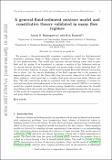A general fluid–sediment mixture model and constitutive theory validated in many flow regimes
Author(s)
Baumgarten, Aaron S; Kamrin, Kenneth N
DownloadSubmitted version (4.334Mb)
Open Access Policy
Open Access Policy
Creative Commons Attribution-Noncommercial-Share Alike
Terms of use
Metadata
Show full item recordAbstract
We present a thermodynamically consistent constitutive model for fluid-saturated sediments, spanning dense to dilute regimes, developed from the basic balance laws for two-phase mixtures. The model can represent various limiting cases, such as pure fluid and dry grains. It is formulated to capture a number of key behaviours such as: (i) viscous inertial rheology of submerged wet grains under steady shearing flows, (ii) the critical state behaviour of grains, which causes granular Reynolds dilation/contraction due to shear, (iii) the change in the effective viscosity of the fluid due to the presence of suspended grains and (iv) the Darcy-like drag interaction observed in both dense and dilute mixtures, which gives rise to complex fluid-grain interactions under dilation and flow. The full constitutive model is combined with the basic equations of motion for each mixture phase and implemented in the material point method (MPM) to accurately model the coupled dynamics of the mixed system. Qualitative results show the breadth of problems which this model can address. Quantitative results demonstrate the accuracy of this model as compared with analytical limits and experimental observations of fluid and grain behaviours in inhomogeneous geometries. ©2018 Cambridge University Press.
Date issued
2018-12Department
Massachusetts Institute of Technology. Department of Aeronautics and Astronautics; Massachusetts Institute of Technology. Department of Mechanical EngineeringJournal
Journal of Fluid Mechanics
Publisher
Cambridge University Press (CUP)
Citation
Baumgarten, Aaron S. and Ken Kamrin, "A general fluid–sediment mixture model and constitutive theory validated in many flow regimes." Journal of Fluid Mechanics 861 (February 2019): 721-64 ©2018 Authors
Version: Original manuscript
ISSN
1469-7645